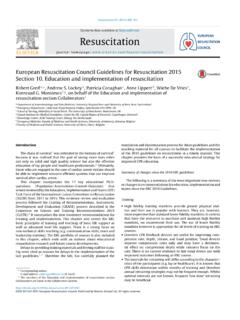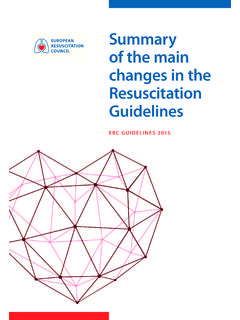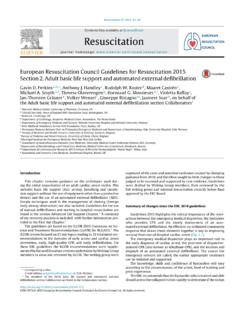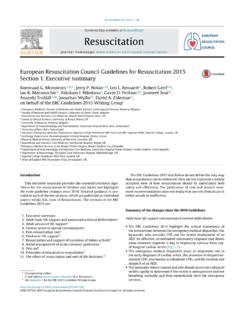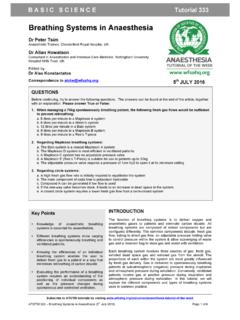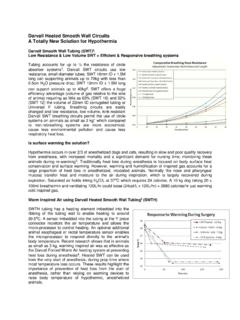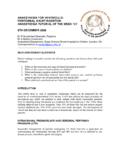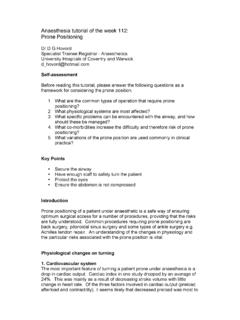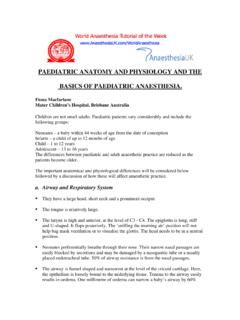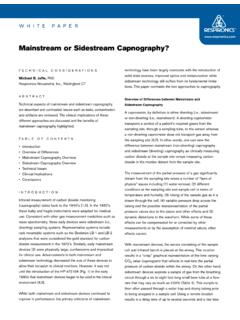Transcription of Contents lists available at ScienceDirect Resuscitation
1 Resuscitation 95 (2015) 100 147 Contents lists available at ScienceDirectResuscitationjou rn al hom epage : w Resuscitation Council Guidelines for Resuscitation 2015 Section 3. Adult advanced life supportJasmeet Soara, , Jerry P. Nolanb,c, Bernd W. B ttigerd, Gavin D. Perkinse,f, Carsten Lottg,Pierre Carlih, Tommaso Pellisi, Claudio Sandronij, Markus B. Skrifvarsk, Gary B. Smithl,Kjetil Sundem,n, Charles D. Deakino, on behalf of the Adult advanced life support sectionCollaborators1aAnaesthesia and Intensive Care Medicine, Southmead Hospital, Bristol, UKbAnaesthesia and Intensive Care Medicine, Royal United Hospital, Bath, UKcSchool of Clinical Sciences, University of Bristol, UKdDepartment of Anaesthesiology and Intensive Care Medicine, University Hospital of Cologne, GermanyeWarwick Medical School, University of Warwick, Coventry, UKfHeart of England NHS Foundation Trust, Birmingham, UKgDepartment of Anesthesiology, University Medical Center, Johannes Gutenberg-University, Mainz, GermanyhSAMU de Paris, Department of Anaesthesiology and Intensive Care, Necker University Hospital, Paris.
2 FranceiAnaesthesia, Intensive Care and Emergency Medical Service, Santa Maria degli Angeli Hospital, Pordenone, ItalyjDepartment of Anaesthesiology and Intensive Care, Catholic University School of Medicine, Rome, ItalykDivision of Intensive Care, Department of Anaesthesiology, Intensive Care and Pain Medicine, Helsinki University Hospital and Helsinki University,Helsinki, FinlandlCentre of Postgraduate Medical Research & Education, Bournemouth University, Bournemouth, UKmDepartment of Anaesthesiology, Division of Emergencies and Critical Care, Oslo University Hospital, Oslo, NorwaynInstitute of Clinical Medicine, University of Oslo, Oslo, NorwayoCardiac Anaesthesia and Cardiac Intensive Care, NIHR Southampton Respiratory Biomedical Research Unit, University Hospital Southampton,Southampton, UKIntroductionAdult advanced life support (ALS) includes advanced interven-tions after basic life support has started and when appropriate anautomated external defibrillator (AED) has been used.
3 Adult basiclife support (BLS) and use of AEDs is addressed in Section 2. Thetransition between basic and advanced life support should be seam-less as BLS will continue during and overlap with ALS section on ALS includes the prevention of cardiac arrest, spe-cific aspects of prehospital ALS, starting in-hospital Resuscitation ,the ALS algorithm, manual defibrillation, airway management dur-ing CPR, drugs and their delivery during CPR, and the treatmentof peri-arrest arrhythmias. There are two changes in the presenta-tion of these guidelines since European Resuscitation Council (ERC)Guidelines is no longer a separate section on electri-cal therapies2and the ALS aspects are now part of this care guidelines are presented in a new section(Section 5) that recognises the importance of the final link in theChain of Corresponding address: (J.)
4 Soar).1 The members of the Adult advanced life support section Collaborators are listedin the Collaborators Guidelines are based on the International Liaison Com-mittee on Resuscitation (ILCOR) 2015 Consensus on Science andTreatment Recommendations (CoSTR) for 2015 ILCOR review focused on 42 topics organised in the approximate sequenceof ALS interventions: defibrillation, airway, oxygenation and ven-tilation, circulatory support, monitoring during CPR, and drugsduring CPR. For these Guidelines the ILCOR recommendations weresupplemented by focused literature reviews undertaken by the ERCALS Writing Group for those topics not reviewed in the 2015 ILCORCoSTR. Guidelines were drafted and agreed by the ALS WritingGroup members before final approval by the ERC General Assemblyand ERC of changes since 2010 GuidelinesThe 2015 ERC ALS Guidelines have a change in emphasis aimedat improved care and implementation of these guidelines in orderto improve patient focused 2015 ERC ALS Guide-lines do not include any major changes in core ALS interventionssince the previous ERC guidelines published in ,2 The keychanges since 2010 are: Continuing emphasis on the use of rapid response systems forcare of the deteriorating patient and prevention of in-hospitalcardiac arrest.
5 Continued emphasis on minimally interrupted high-qualitychest compressions throughout any ALS intervention: 2015 European Resuscitation Council. Published by Elsevier Ireland Ltd. All rights Soar et al. / Resuscitation 95 (2015) 100 147 101compressions are paused briefly only to enable specific inter-ventions. This includes minimising interruptions in chestcompressions to attempt defibrillation. Keeping the focus on the use of self-adhesive pads for defibrilla-tion and a defibrillation strategy to minimise the preshock pause,although we recognise that defibrillator paddles are used in somesettings. There is a new section on monitoring during ALS with anincreased emphasis on the use of waveform capnography to con-firm and continually monitor tracheal tube placement, quality ofCPR and to provide an early indication of return of spontaneouscirculation (ROSC).
6 There are a variety of approaches to airway management duringCPR and a stepwise approach based on patient factors and theskills of the rescuer is recommended. The recommendations for drug therapy during CPR have notchanged, but there is greater equipoise concerning the role ofdrugs in improving outcomes from cardiac arrest. The routine use of mechanical chest compression devices is notrecommended, but they are a reasonable alternative in situa-tions where sustained high-quality manual chest compressionsare impractical or compromise provider safety. Peri-arrest ultrasound may have a role in identifying reversiblecauses of cardiac arrest. Extracorporeal life support techniques may have a role as a rescuetherapy in selected patients where standard ALS measures are Prevention of in-hospital cardiac arrestEarly recognition of the deteriorating patient and prevention ofcardiac arrest is the first link in the chain of cardiacarrest occurs, only about 20% of patients who have an in-hospitalcardiac arrest will survive to go ,7 The key recommendations for the prevention of in-hospital car-diac arrest are unchanged since the previous guidance in suggest an approach to prevention of in-hospital cardiac arrestthat includes staff education, monitoring of patients, recognitionof patient deterioration.
7 A system to call for help and an effectiveresponse the chain of problemCardiac arrest in patients in unmonitored ward areas is notusually a sudden unpredictable often have slowand progressive physiological deterioration, involving hypox-aemia and hypotension that is unnoticed or poorly managedby ward 12 The initial cardiac arrest rhythm is usuallynon-shockable6,7and survival to hospital discharge is poor, partic-ularly in patients with preceding signs of respiratory depressionor ,13 Early and effective treatment might prevent somecardiac arrests, deaths and unanticipated ICU admissions. Studiesconducted in hospitals with traditional cardiac arrest teams haveshown that patients attended by the team but who were found notto have a cardiac arrest, have a high morbidity and 16 Registry data from the US suggests that hospitals with lowest inci-dence of IHCA also have the highest CA of the deficiencies in the recognition and response topatient deteriorationThese include infrequent, late or incomplete vital signs assess-ments; lack of knowledge of normal vital signs values; poor designof vital signs charts; poor sensitivity and specificity of track andtrigger systems.
8 Failure of staff to increase monitoring or esca-late care, and staff 26 Problems with assessing andtreating airway, breathing and circulation abnormalities as wellorganisational problems such as poor communication, lack of team-work and insufficient use of treatment limitation plans are ,27,28 Education in acute careSeveral studies show that medical and nursing staff lack knowl-edge and skills in acute care,29 oxygen therapy,30fluidand electrolyte balance,31analgesia,32issues of consent,33pulseoximetry,30,34,35and drug education is an essentialpart of implementing a system to prevent cardiac arrest but to date,randomised controlled studies addressing the impact of specificeducational interventions are one study, virtually all the improvement in the hospitalcardiac arrest rate occurred during the educational phase of imple-mentation of a medical emergency team (MET) ,39 Rapidresponse teams, such as METs, play a role in educating and improv-ing acute care skills of ward ,40 The introduction ofspecific, objective calling criteria,41referral tools42and feedbackto caregivers43has resulted in improved MET use and a significantreduction in cardiac arrests.
9 Another study found that the numberof cardiac arrest calls decreased while pre-arrest calls increasedafter implementing a standardised educational programme44intwo hospitals45; this was associated with a decrease in CA incidenceand improved CA survival. Other research suggests that multi-professional education did not alter the rate of mortality or staffawareness of patients at risk on general and recognition of the critically ill patientClinical signs of acute illness are similar whatever the underly-ing process, as they reflect failing respiratory, cardiovascular andneurological systems. Alterations in physiological variables, singlyor in combination are associated with, or can be used to predictthe occurrence of cardiac arrest,12,47 50hospital death20,21,51 68and unplanned ICU admission,47,66,69,70and with increasing mag-nitude and number of derangements the likelihood of death ,47,48,63,71 79 Even though abnormal physiology is com-mon on general wards,80the measurement and documentation ofvital signs is ,11,22,49,81 83To assist in the early detec-tion of critical illness, each patient should have a documented planfor vital signs monitoring including which physiological measure-ments needs no be undertaken and ,84 Many hospitals use early warning scores (EWS)
10 Or calling crite-ria to identify ward patients needing escalation of care,22,49,82,85 89and this increases vital signs ,88,89 These calling crite-ria or track and trigger systems include single-parameter systems,multiple-parameter systems, aggregate weighted scoring systemsor combination weighted track a
